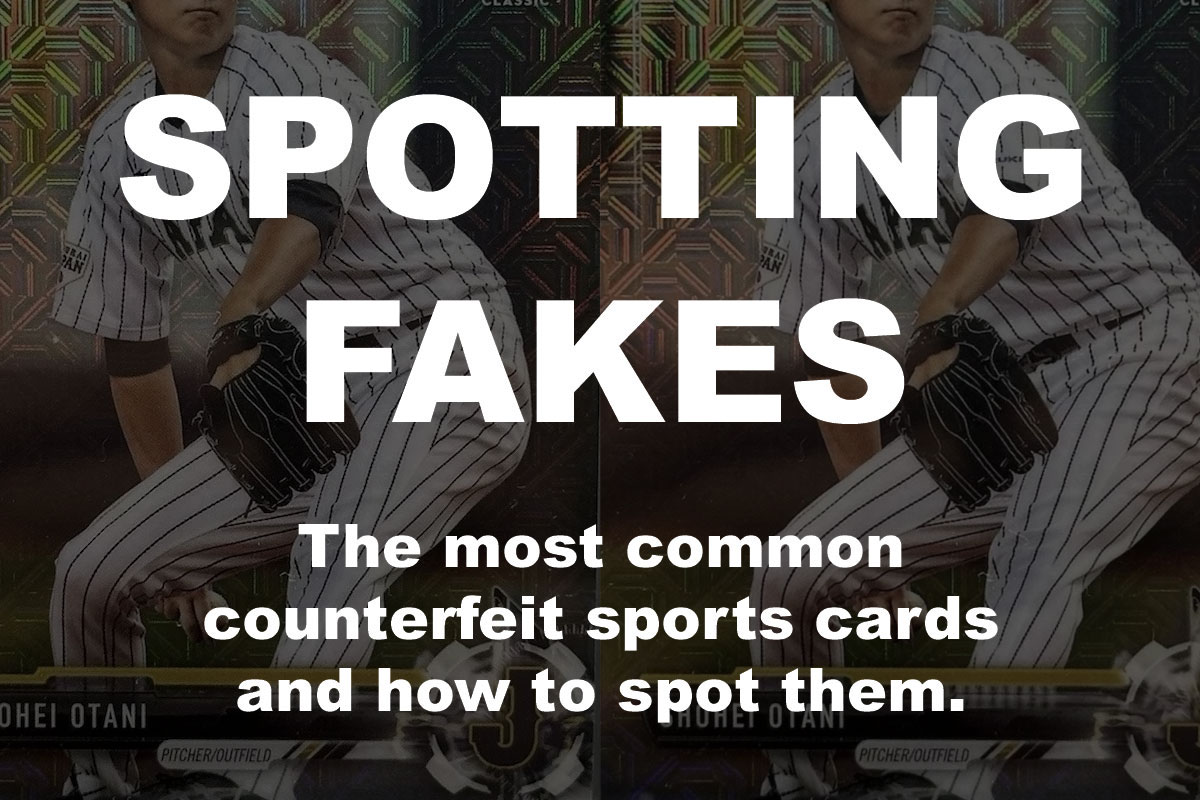How to Spot Counterfeit Sports Cards
The most common counterfeit sports cards and how to spot them.
Counterfeit sports cards have long been an issue for collectors to navigate, but fake sports cards are becoming more prevalent as technology has improved. The most common counterfeit sports cards are often the classic vintage cards most collectors can only dream of owning. If you come across a great deal and think it’s too good to be true, it probably is. Stop and examine the card for common signs it’s a counterfeit.
How to Identify Counterfeit Sports Cards
As technology has improved and more people buy and sell trading cards on online marketplaces, it’s becoming more difficult to tell if a card is real or fake. However, there are a few signs that indicate a card may not be authentic.
Companies like PSA will have images of the front and back of cards they have authenticated and graded. Pull up these images and compare them to the card you’re looking at. If a card has any of the following, consider it a red flag.
Assess the Print Quality for These 4 Main Things
Many of the signs that a card may be counterfeit are in the print quality. This includes the colors, text, image clarity, and the print pattern and style used during the era.
- Colors: The colors used on counterfeit cards may not be as vibrant or consistent as those on authentic cards. If the card’s color looks faded, washed out, or inconsistent, this is a sign it might not be authentic.
- Text: Counterfeiters may not be able to find the exact match for the font used for the player’s name or team. Compare the size and style of the letters to a card you know is authentic. If it looks off, it could be fake.
- Image Clarity: The image on the card should be crisp and vivid. If the photo of the player or the team logo looks blurry or hazy, that’s a sign it isn’t authentic.
- Print Pattern and Style: Many vintage cards were printed with a specific style. When assessed under magnification, authentic cards will have a honeycomb pattern. It can be helpful to compare your card to other low-value, common cards from the same set.
Examine the Cardstock, Thickness, and Shine
The cardstock, thickness, and shine on authentic cards have distinguishable differences from many of the fakes on the market. Here’s what you should look for in these three areas.
- Cardstock: The cardstock should be sturdy and durable, rather than flimsy and fragile. Also compare the color of the cardstock to other common cards from the set. If the cardstock looks too bright or dull compared to other cards from that set, it might not be authentic.
- Thickness: Check the thickness of the card by holding it up to a light or shining a flashlight on it. Authentic vintage cards are printed on thicker cardstock that does not allow light to shine through it. Counterfeit cards are often printed on thinner paper that you can see right through when held up to a light.
- Shine: The look and feel of an authentic card can be tough to replicate. Fake cards can look overly glossy or suspiciously smooth. You can also use a blacklight to check for a shine. Under the blacklight, authentic vintage cards should appear dull or have minimum shine. If a vintage card glows under a blacklight, it’s safe to assume it’s fake.
Check for Signs of Artificial Aging
Another thing counterfeiters are known to do is purposefully damage the fake cards to make them appear more authentic. Collectors are rightfully wary of cards half a century old that are in perfect condition. There are normal signs of wear with vintage cards, so counterfeiters will scuff up the surface or dull the edges and corners. If the wear and tear look repeated or unnatural, it could be a sign that it was altered to appear more legitimate.
The Most Common Counterfeit Sports Cards
Vintage and rookie cards from the GOATs are the most common counterfeit sports cards because, when authentic, they are some of the most rare and valuable cards. When buying ungraded copies of the following cards, it’s important to proceed with caution.
1986 Fleer Michael Jordan #57
The Michael Jordan rookie card was the most submitted fake to PSA in 2024. PSA, the top authentication and grading company, reported that a quarter of all copies it received for grading were counterfeits.
1952 Topps Mickey Mantle #311
Mickey Mantle’s rookie card is one of the most famous sports cards of all time. It holds the record for the most expensive sports card when it sold for $12.6 million in 2022. This makes it a popular target for counterfeiters. In 2024, PSA received more fake copies of this card than they did authentic ones.
1979 O-Pee-Chee Wayne Gretzky #18
This Wayne Gretzky rookie card is a popular target because of its scarcity. There are only two PSA 10 Gem Mint copies of this card. Unassuming collectors may leap at this Gretzky rookie in good condition, but counterfeiters know this and are quick to take advantage.
1933 Goudey Babe Ruth & Lou Gehrig
The 1933 Goudey set is nearly 100 years old and includes cards of many Hall of Famers, including Babe Ruth and Lou Gehrig. Their value makes them some of the most common counterfeit sports cards.
1909-11 T206 Honus Wagner
The T206 Honus Wagner is considered the Holy Grail of trading cards. The set was produced from 1909 to 1911 and sold with packs of cigarettes. Because of the value of authentic T206 cards, counterfeiters have been trying to make high-quality fakes for decades.
Buy Authentic Cards from Sellers You Trust
Counterfeit sports cards are everywhere, so it’s important to know how to spot the red flags that signal the card might be fake. Where there’s a lot of money on the line, only buy from sellers you trust. Head over to the AA Mint Cards online store to check out our wide selection of authenticated and graded sports cards.




